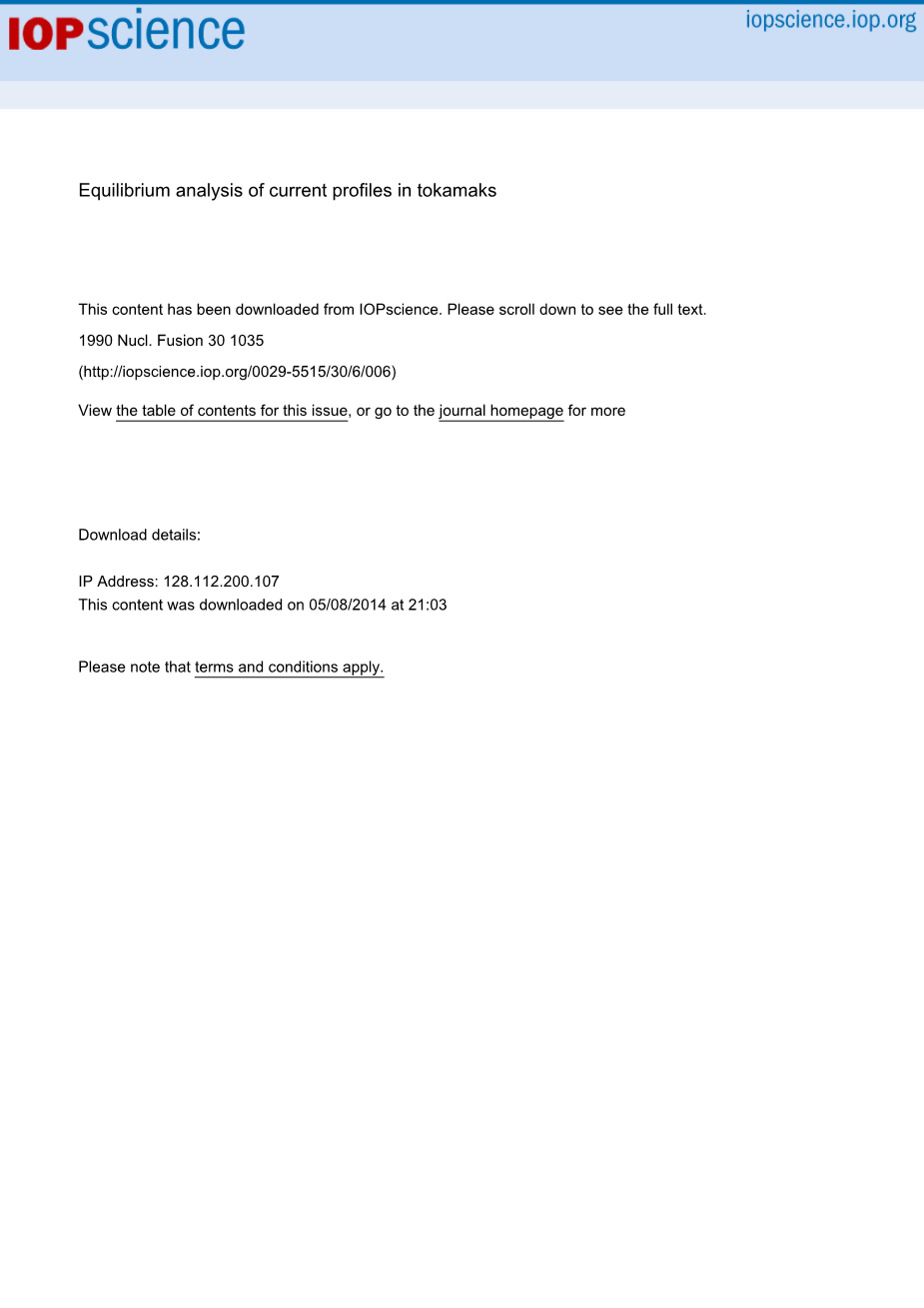本科毕业设计(论文)
外文翻译
Equilibrium analysis of current profiles in tokamaks
作者:L.L. LAO, J.R. FERRON, R.J. GROEBNER, W. HOWL,
H. St. JOHN, E.J. STRAIT, T.S. TAYLOR
国籍:San Diego, California,
United States of America
出处:1990 Nucl. Fusion 30 1035
原文正文:
ABSTRACT.
An efficient method is given for self-consistent reconstruction of the tokamak current profiles and their associated magnetic topology using the Magnetohydrodyna-
mic (MHD) equilibrium constraint from external magnetic measurements, kinetic profile measurements, internal poloidal magnetic field measurements, and topological information from soft X-ray (SXR) measurements. Illustrative examples for beam heated H-mode divertor discharges in the DIII-D tokamak are presented, using the experimentally measured kinetic profile information and external magnetic data from the existing diagnostics. Comparative reconstructions of the current profile using various combinations of diagnostics are given. Also presented is an alternative magnetic analysis method in which the MHD equilibrium is reconstructed using external magnetic data and a constraint on the edge pressure gradient. The results of a sensitivity study are given which show that the axial safety factor q(0) can be more accurately determined when additional information from internal poloidal magnetic measurements is used in conjunction with the external magnetic, kinetic and SXR topological data.
1. INTRODUCTION AND SUMMARY
Progress in both experimental and analytical techniques for magnetic analysis in the last few years has made it an essential part of data analysis in tokamaks. Many efficient and elaborate methods and numerical codes for magnetic analysis [1-7] have been developed and are in routine use at major tokamak laboratories. It is well known that external magnetic measure ments alone only yield the plasma shape and global current profile parameters such as and in tokamaks [8-10]. On the other hand, for the study and understanding of magnetohydrodynamic (MHD) stability and transport, in adition to the global parameters, it is essential to obtain information on the internal plasma profile, such as the shape of the toroidal current density distribution and the profile of the safety factor q. Furthermore, such knowledge permits an accurate full reconstruction of MHD equilibria from the experimental data and, hence, accurate MHD stability analysis. This, in turn, makes possible a precise
interpretation of the stability analysis results and provides useful guidance for further optimization of the plasma current profile against these instabilities. A pioneering work of reconstructing the MHD equilibrium from kinetic profile data was carried out for the Impurity Study Experiment (ISX-B) [11].
However, in this case the reconstruction was performed in two separate steps for simplicity. First, the plasma boundary was determined from external magnetic data alone. Then, the internal current profile was determined from kinetic measurements, and the location of the q = 1 surface, which was obtained with soft X-ray diagnostics, using a fixed boundary equilibrium constraint. Not included in the reconstruction was information on the current profile contained in the external magnetic data as well as information on the boundary shape contained in the kinetic profile data, and the two steps were not combined self-consistently. This paper describes an efficient method to reconstruct the profile of the toroidal current density JT and its associated magnetic topology self-consistently using the MHD equilibrium constraint from many of the available profile diagnostics for tokamaks. These include internal poloidal magnetic field measurements, such as those from from spectroscopy and Faraday rotation, and kinetic profile information from, for instance, Thomson scattering and charge exchange recombination (CER) spectroscopy, which measure the electron density and temperature and the ion temperature, respectively. To provide a self-consistent reconstruction, these data are used in conjunction with external magnetic measurements and magnetic surface topological information, such as the plasma elongation near the magnetic axis, KM, and the location of the q = 1 surface from the soft X-ray (SXR) emission profile. The current density profile as well as the flux NUCLEAR FUSION, Vol.30, No.6 (1990) 1035LAO et al. surface topology are determined from information consistent with all these diagnostic data weighted by their respective uncertainties in the measurements. Such a self-consistent reconstruction is essential, particularly in non-circular toroidal geometry, since any unfolding of the local kinetic data and the internal poloidal magnetic field measurements into useful profile information requires a detailed knowledge of the flux surface topology. The magnetic topology, the current and the pressure profile are, in turn, interrelated through Amperes law and the non-linear MHD equilibrium constraint. Several works in this direction have been reported [12-15]. A full equilibrium reconstruction, consistently including the effects of both pressure anisotropy and plasma rotation, is beyond the scope of this paper. Rather, the plasma is modelled as an isotropic and stationary fluid in equilibrium, which is approximately correct for the DIII-D discharges considered here, as was done for the JET discharges in Ref. [7]. We give examples illustrating various aspects of the equilibrium current profile reconstruction using kinetic and external magnetic data from DIII-D beam heated H-mode divertor discharges which show,
剩余内容已隐藏,支付完成后下载完整资料


英语原文共 16 页,剩余内容已隐藏,支付完成后下载完整资料
资料编号:[276407],资料为PDF文档或Word文档,PDF文档可免费转换为Word
以上是毕业论文外文翻译,课题毕业论文、任务书、文献综述、开题报告、程序设计、图纸设计等资料可联系客服协助查找。


